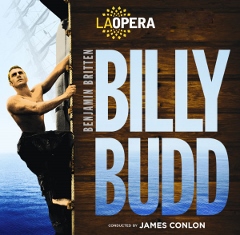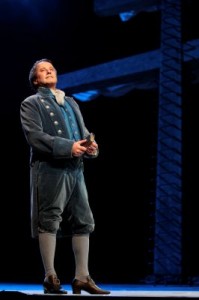LOST AT SEA
To culminate a year-long centennial celebration of British composer Benjamin Britten, L.A. Opera revisits the acclaimed Francesca Zambello production of his 1951 seafaring opera Billy Budd that first set sail at the Dorothy Chandler Pavilion in 2000. With themes as tumultuous as good vs evil, the powerful vs the powerless, regret and remorse, and the complete annihilation of innocence, one might expect 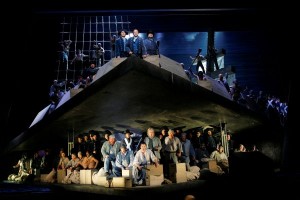 rough and stormy seas that toss and turn the viewer drowning them in emotional swells. What we get instead is mostly smooth sailing devoid of any waves of subtext or depth.
rough and stormy seas that toss and turn the viewer drowning them in emotional swells. What we get instead is mostly smooth sailing devoid of any waves of subtext or depth.
Based on the Herman Melville novella with a libretto by E. M. Forster and Eric Crozier, the tale opens with a prologue featuring a troubled Captain Vere (Richard Croft) reflecting on a decision he has agonized over and which has haunted him for years, setting up a two-act flashback which is then buttoned by the Captain’s epilogue.
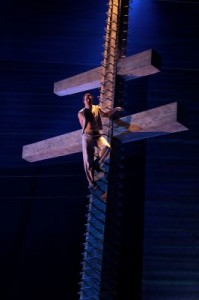 Floating down memory lane, we are transported to 1797 aboard the HMS Indomitable as England is at war with France. The ship’s crew, a microcosm of society, is under the strict rule of the cruel and overbearing master-at-arms John Claggart (Greer Grimsley). When Billy (Liam Bonner) and two not-so-voluntary recruits are brought on board to join the crew, Claggart takes an immediate dislike to Billy’s “goodness and beauty.” While previous productions have suggested Claggart’s problem with the strapping young lad is a result of homosexual undercurrents, no such insinuation is alluded to in this go-round. In fact, there is very little on display to justify his hatred as he sets out to frame Billy for mutiny. The unprovoked persecution begs comparisons to both literal and religious sources such as Javert’s relentless pursuit of Jean Valjean in Les Miserables and Pontius Pilate’s crucifixion of Jesus. Just as Jean Valjean and J.C. were beloved by the masses, Billy is beloved by the crew and comes to represent all that is good and pure. Early on, Billy climbs the cross-shaped mast and spreads his arms in a blatant foreshadowing of what’s to come.
Floating down memory lane, we are transported to 1797 aboard the HMS Indomitable as England is at war with France. The ship’s crew, a microcosm of society, is under the strict rule of the cruel and overbearing master-at-arms John Claggart (Greer Grimsley). When Billy (Liam Bonner) and two not-so-voluntary recruits are brought on board to join the crew, Claggart takes an immediate dislike to Billy’s “goodness and beauty.” While previous productions have suggested Claggart’s problem with the strapping young lad is a result of homosexual undercurrents, no such insinuation is alluded to in this go-round. In fact, there is very little on display to justify his hatred as he sets out to frame Billy for mutiny. The unprovoked persecution begs comparisons to both literal and religious sources such as Javert’s relentless pursuit of Jean Valjean in Les Miserables and Pontius Pilate’s crucifixion of Jesus. Just as Jean Valjean and J.C. were beloved by the masses, Billy is beloved by the crew and comes to represent all that is good and pure. Early on, Billy climbs the cross-shaped mast and spreads his arms in a blatant foreshadowing of what’s to come.
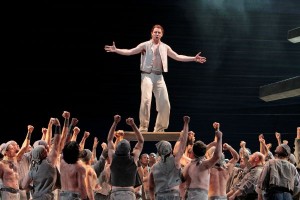 Much of the action is slow, plodding, and uninvolving. At the end of Act I when Billy is warned of Claggart’s plan, his innocence and naiveté prevents him from believing such an undermining is real. Act II opens with a rousing call-to-battle scene followed by Claggart’s accusation and the ultimate confrontation. When Billy, who suffers from stammering, is tongue-tied and unable to defend himself against the attack, he strikes out at Claggart and kills him. A court martial ensues condemning Billy to swing from the yardarm. While the emotionality of the piece increases in intensity throughout the second act, it never builds to a climax which satisfies the demands of the plot.
Much of the action is slow, plodding, and uninvolving. At the end of Act I when Billy is warned of Claggart’s plan, his innocence and naiveté prevents him from believing such an undermining is real. Act II opens with a rousing call-to-battle scene followed by Claggart’s accusation and the ultimate confrontation. When Billy, who suffers from stammering, is tongue-tied and unable to defend himself against the attack, he strikes out at Claggart and kills him. A court martial ensues condemning Billy to swing from the yardarm. While the emotionality of the piece increases in intensity throughout the second act, it never builds to a climax which satisfies the demands of the plot.
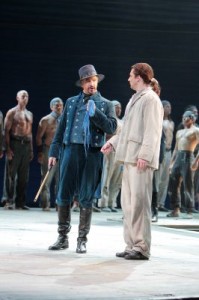 Mr. Britten’s score successfully conjures up the vast and shifting tides of the ocean and the dark and brooding consequences of rampant oppression and the pangs of injustice. James Conlon wields his baton well and does an excellent job interpreting the music. Britten’s handling of the libretto, however, is another story. The words are mostly delivered in an atonal straight-forward fashion without a melody in sight. While it’s conversational and direct, it is not particularly pleasing to the ear and can be a challenge to listen to. Although the opera is in English there are supertitles which, as it turns out, come in quite handy; the vocals are filled with nautical terms that would be impossible to decipher without them. In addition, while the presence of vocal acrobatics is virtually nonexistent, there are the occasional flourishes which render every day words indistinguishable. The closest we come to an actual aria doesn’t arrive until the end of the second act. The final laments of both the Captain and Billy are quite effective and gratifyingly musical.
Mr. Britten’s score successfully conjures up the vast and shifting tides of the ocean and the dark and brooding consequences of rampant oppression and the pangs of injustice. James Conlon wields his baton well and does an excellent job interpreting the music. Britten’s handling of the libretto, however, is another story. The words are mostly delivered in an atonal straight-forward fashion without a melody in sight. While it’s conversational and direct, it is not particularly pleasing to the ear and can be a challenge to listen to. Although the opera is in English there are supertitles which, as it turns out, come in quite handy; the vocals are filled with nautical terms that would be impossible to decipher without them. In addition, while the presence of vocal acrobatics is virtually nonexistent, there are the occasional flourishes which render every day words indistinguishable. The closest we come to an actual aria doesn’t arrive until the end of the second act. The final laments of both the Captain and Billy are quite effective and gratifyingly musical.
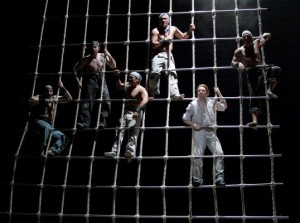 The staging by Julia Pevzner (based on Ms. Zambello’s original direction) features some interesting configurations of the 93-member all-male cast (the deck-scrubbing scene and the second act opener are very effective) but too often resorts to “clump and dump” groupings with the leads hitting their marks for a “park and bark” delivery. As previously mentioned, any subtext is cast overboard like so much flotsam and jetsam in favor of a full-steam-ahead approach. Of the leads Mr. Bonner fares the best. He convincingly captures Billy’s goodness and possesses a rich full baritone voice which has all the power and strength needed to soar to the heights of the upper balcony. Mr. Croft and Mr. Grimsley offer up good characterizations but lack Mr. Bonner’s diaphragm, and are often difficult to hear. The remaining featured artists are all very good with what little they are given to do. Surprisingly, the massive chorus (under the direction of Grant Gershon) is remarkably subdued. Considering their size, you would expect them to blow the roof off the joint but they are never given the chance.
The staging by Julia Pevzner (based on Ms. Zambello’s original direction) features some interesting configurations of the 93-member all-male cast (the deck-scrubbing scene and the second act opener are very effective) but too often resorts to “clump and dump” groupings with the leads hitting their marks for a “park and bark” delivery. As previously mentioned, any subtext is cast overboard like so much flotsam and jetsam in favor of a full-steam-ahead approach. Of the leads Mr. Bonner fares the best. He convincingly captures Billy’s goodness and possesses a rich full baritone voice which has all the power and strength needed to soar to the heights of the upper balcony. Mr. Croft and Mr. Grimsley offer up good characterizations but lack Mr. Bonner’s diaphragm, and are often difficult to hear. The remaining featured artists are all very good with what little they are given to do. Surprisingly, the massive chorus (under the direction of Grant Gershon) is remarkably subdued. Considering their size, you would expect them to blow the roof off the joint but they are never given the chance.
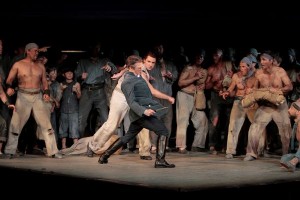 Alison Chitty’s set design is an expansive and severely raked stage which juts out over the orchestra pit and serves at the deck of the ship. (The rake is so steep I felt badly for the performers, whose backs and legs will surely be feeling its effects long after they leave the stage; I kept imagining that one false step would cause a chain reaction sending then all tumbling into the string section.) There is a prominently featured double-beamed mast and some hidden doors in the flooring and little else. For most of the first act it sits there stagnant and doesn’t come to life until the call-to-battle scene at the start of Act II. At that point, as the cast scrambles to man their stations, hydraulics raise the stage revealing a sub level, faux cannons are lifted, and staircases are revealed. Later on in the act some rigging is lowered; with the help of Alan Burrett’s excellent lighting the stage pictures that are created when all the pieces are in play are quite spectacular.
Alison Chitty’s set design is an expansive and severely raked stage which juts out over the orchestra pit and serves at the deck of the ship. (The rake is so steep I felt badly for the performers, whose backs and legs will surely be feeling its effects long after they leave the stage; I kept imagining that one false step would cause a chain reaction sending then all tumbling into the string section.) There is a prominently featured double-beamed mast and some hidden doors in the flooring and little else. For most of the first act it sits there stagnant and doesn’t come to life until the call-to-battle scene at the start of Act II. At that point, as the cast scrambles to man their stations, hydraulics raise the stage revealing a sub level, faux cannons are lifted, and staircases are revealed. Later on in the act some rigging is lowered; with the help of Alan Burrett’s excellent lighting the stage pictures that are created when all the pieces are in play are quite spectacular.
While I was tempted to walk the plank out of boredom by the end of Act I, the second half managed to fill my sails with enough wind to keep me interested through to the end. Had I not been required to stay for Act II, it would have surely been a bon voyage at intermission.
Billy Budd
Los Angeles Opera
in association with
the Royal Opera House, Covent Garden (London)
and the Paris Opera
The Music Center’s Dorothy Chandler Pavilion
135 North Grand Avenue
scheduled to end on March 16, 2014
for tickets, call 213.972.8001
or visit www.LAOpera.com
